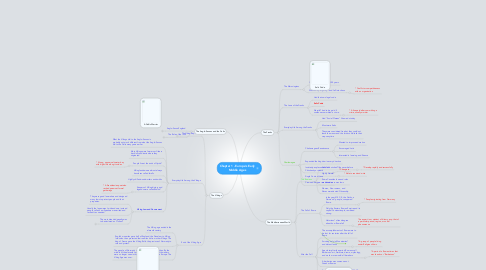
1. The Vikings
1.1. The Viking Reputation
1.1.1. Attacked Paris on Easter in 855
1.1.2. Travelled in Longships* for easy attacks
1.1.2.1. * A special ship designed by the Vikings that moved in fast and then left before anyone had time to act
1.1.3. Common practice to kill or enslave every man, woman and child.
1.1.4. Attacked Charlemagnes Empire
1.1.5. Many people they were sent by god to punish the world
1.1.6. Some monarchs and church leaders were so scared that they paid the Vikings to leave their land.
1.1.7. Only few rulers such as Alfred the Great and Charlemagne were able to fight the VIkings
1.2. Everyday Life Among the Vikings
1.2.1. What the Vikings did to the Anglo-Saxons is probably not much different from what the Anglo-Saxons did to the Celts many years earlier
1.2.2. Most Vikings were farmers or fishers back in Scandinavia where they originated
1.2.3. People live at the ends of fjords*
1.2.3.1. * A long, narrow, salt-water bay with high cliffs along its sides
1.2.4. Viking landowners almost always has slaves called thralls
1.2.5. Highly skilled woodworkers and smiths
1.2.6. Keepers of Viking history and legends were called Skalds*
1.2.6.1. * A Scandinavian poet who recited poems at formal gatherings
1.2.7. Viking Law and Government
1.2.7.1. They were good lawmakers and designed many laws to protect people and their properties.
1.2.7.2. Usually the laws weren't written down, instead people called Law Speakers memorized and recited it as needed.
1.2.7.3. The most dreaded penalty was to be declared an Outlaw*
1.2.7.3.1. * Treated as if you were dead, anyone could kill you on sight and be entitled to some of your property
1.3. End of the Viking Age
1.3.1. The Viking age ended in the eleventh century
1.3.2. English monarchs gave half of England, the Danelaw, to Viking lords who then protected their new lands from other Vikings. The king of France gave the Viking Rollo the province of Normady to rule and protect.
1.3.3. The people of Normady and Denmark became Christian. By the middle of the eleventh century, dragon ships filled with warriors were no longer seen in the rivers and seas of western Europe. The Viking Age was over.
2. The Anglo-Saxons and the Celts
2.1. Anglo-Saxon England
2.1.1. Most were farmers
2.1.2. Lived in small villages, men and woman shared work
2.1.3. They were great storytellers
2.1.3.1. Made stories such as "Beowulf"
2.1.4. Alfred the Great
2.1.4.1. Lost many battles with the Vikings
2.1.4.2. United Englad and made it Prosperous*
2.1.4.2.1. * Successful in material terms
2.1.5. Suffered from weak kings and Viking attacks until William the Conqueror came
2.2. The Role of the Irish
2.2.1. Practiced Druidism*
2.2.1.1. * The system of religion practiced by a druid
2.2.2. Bloody Battles, kept slaves, and made sacrifices
2.2.3. St. Patrick
2.2.3.1. Brought Irish to Christianity
2.2.3.2. Brought lots of Monasteries
2.2.4. Carried Books hooked to their belts
2.2.5. Copied many greek, roman and celtic stories that otherwise would be lost forever.
3. Viking Longship
4. A Celtic Warrior
5. The Mediterranean World
5.1. The Romans
5.1.1. Culture flourished* like never before
5.1.1.1. * Develop rapidly and successfully
5.1.2. Highly literate*
5.1.2.1. * Able to read and write
5.1.3. Some Canadian laws and rules are based on roman laws
5.1.4. Women, Non-romans, and Slaves were denied Citizenship
5.2. The Fall of Rome
5.2.1. In the year 410 C.E, the Goths, a Germanic* people, conquered Rome.
5.2.1.1. * People originating from Germany
5.2.2. Only the Eastern Roman Empire and its capital Constantinople, remained strong.
5.2.3. Historians* often disagree about how Rome fell
5.2.3.1. *An expert in or student of history, esp. that of a particular period, region, or social phenomenon
5.3. After the Fall
5.3.1. The accomplishments of Rome were to be lost for centuries after the fall of Rome
5.3.2. Surviving only in Monasteries* and distant lands
5.3.2.1. * A group of people living under Religious Vows
5.3.3. Ages later after the period Romans call Barbarous* art, literature, drama, mythology, and much more would all be reborn
5.3.3.1. * A period in Roman times that was chaotic or "Barbarious"
5.3.4. A barbarian was someone not Greek or Roman
5.3.5. Europe was in a horrible age until 800 C.E when Pope Leo the 3rd crowned Charlemanne Emperor of the Romans and widespread civilization began
6. The Franks
6.1. The Merovingians
6.1.1. Ruled Franks for almost 300 years
6.1.2. Weaked by infighting* and fell into chaos
6.1.2.1. * Conflict or competitiveness with an organization
6.2. The Laws of the Franks
6.2.1. Had their own legal code
6.2.2. Salic Code
6.2.3. Wergild* had to be paid if someone committed a crime.
6.2.3.1. * A fine paid after committing a crime, usually murder
6.3. Everyday Life Among the Franks
6.3.1. Had "Social Classes" like we do today
6.3.2. Most were Serfs
6.3.3. They were considered free but they could not leave the manor and the lords could take their crops anytime
6.4. Charlemagne
6.4.1. Charlemagnes Renaissance
6.4.1.1. Wanted to improve education
6.4.1.2. Encouraged Latin
6.4.1.3. Interested in learning and Science
6.4.2. Expanded the kingdom in every direction
6.4.3. Insisted people convert* to Christianity or death
6.4.3.1. * Change to
6.4.4. Single Code of Laws
6.4.5. Crowned Emperor on christmas
